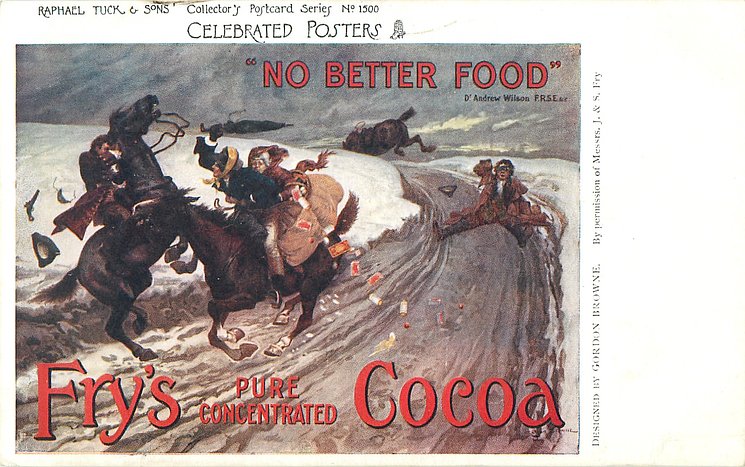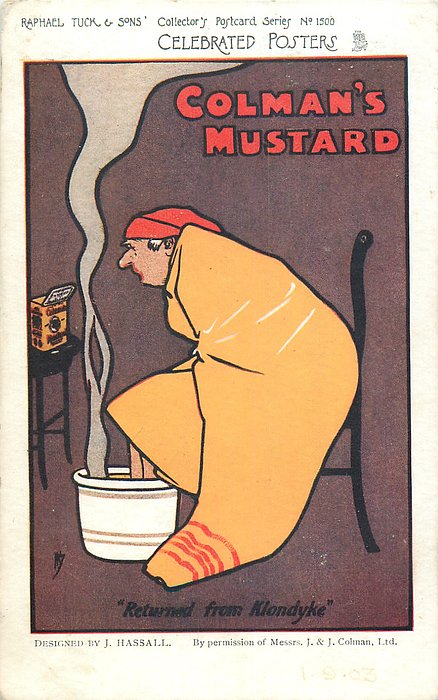Early in 1903, Tuck added a seven-card set to its catalog. Yes, seven is an unusual number in a set, but there was a good reason. The set was comprised of advertising posters accomplished by some of Britain’s most successful illustrators – among them were John Hassall, Gordon Brown, and Harry Furniss. The set was sold only in the United Kingdom but was highly acclaimed and popular because of their vibrant colors, intricate designs, and diverse subject matter.
The cards captured the essence of products used in everyday life but have no other common characteristic since the artists (designers/illustrators) differed so dramatically. All seven cards have come to be collectible items, sought after by art fans as well as advertising enthusiasts and postcard collectors.

The seven original posters advertised five very different products. There are two advertisements for cocoa, Cadbury’s and Fry’s. There is one each for a brand of laundry blue and one for a wheat-malt cereal, two for Pear’s Soap, and one for Colman’s Mustard.
Colman’s Mustard is a first-quality mustard that has been made for over 200 years and sold around the world. (And, as one may expect, some of their products have culinary reputations and price tags to match. One of Colman’s specialty mustards, made using North African and Egyptian mustard seeds, when shipped to your front door will cost you $32.50 for 3.5 ounces.)

Jeremiah Colman was the son of an English miller. When he was only 37 (in 1814) he founded his own company in Norfolk, England and created his much admired condiment using recipes found in his mother’s and neighbor’s kitchens.
The unique and bold flavor of the mustard is why Colman’s has such enduring popularity. Even the “household” mustard that sells for just $3 in a six-ounce jar is made using blends of high-quality white and brown mustard seeds. Regardless of how it is used – to spice up meat in a sandwich, mixed into a sauce, or used as a marinade – Colman’s Mustard never fails to add depth and complexity to food.
One noteworthy factor in Colman’s success is its versatility. They create a wide range of products. Classic English mustard, mustard paste, smooth mustard, and mustard powder are but a few of the Colman products that are used in dressings, sauces, and marinades. And for those who prefer a milder mustard, the mustard powder can be mixed with water or vinegar to create homemade mustard paste suitable for any taste.
The icing on the cake (no, there is no known recipe for mustard icing) is mustard is good for you. Mustard has at least a dozen health benefits. Mustard seeds are rich in vitamins and minerals, including vitamin C, iron, calcium, and magnesium. Adding mustard to your diet makes what you eat nutrient dense. Mustard seeds are high in antioxidants, which can help ease emotional and muscle stress. And if your diet has a modicum of mustard, it will prevent inflammation in the body and aid in digestion.
In his lifetime, Jeremiah Colman and his wife, Anne, never had children, so he partnered, in his mustard business, with his nephew, James Colman. In addition to being a successful businessman and later in life (1846), the mayor of Norwich, England, knew nothing of this, but he would certainly be proud to discover how his mustard has become a culinary treasure that has stood the test of time.
Hard to believe any mustard is worth nearly ten dollars an ounce!
Thank you Tim for your comprehensive story on Coleman Mustard. These 7 cards are part of Tuck’s 1500 Series. For those searching for addition poster art Tuck also did a 1501, 1502 and 1503 Series as well as at least 2 French “Les Affiches Célébres” series. All of these cards are hard to find.
A tasty article indeed. Hope the diet info is true. Not liking the mustard taste much at least I can fit in with husband’s choice to help defeat any bothersome inflamation and add extra nutrients and anti-oxcidents. Thanks, and excuse hurried spellings.